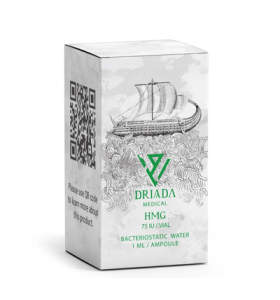Pure HMG for Sale – Clinically Proven for Ovulation Induction
HMG (Human Menopausal Gonadotropin): Fertility and Hormonal Support for Men and Women
What Is HMG?
HMG, or Human Menopausal Gonadotropin, is a hormone medication extracted from the urine of postmenopausal women. It contains a combination of follicle-stimulating hormone (FSH) and luteinizing hormone (LH) — two key hormones involved in the regulation of reproductive function.
It is primarily used in fertility treatments but also has off-label applications in testosterone optimization, especially for men recovering from anabolic steroid use or managing testosterone replacement therapy (TRT).
How It Works
In women, HMG stimulates ovarian follicle development, triggering ovulation and supporting fertility.
In men, HMG acts on the testes to:
Stimulate sperm production (spermatogenesis)
Boost natural testosterone levels
Support testicular function and size
HMG mimics the body’s natural pituitary hormones, making it especially valuable in cases of secondary hypogonadism or infertility.
Key Benefits
In Men:
Restores natural testosterone during or after suppression (e.g. post-steroid cycle)
Promotes sperm production — often used in fertility protocols
Reverses testicular atrophy caused by exogenous testosterone or AAS
Works synergistically with HCG for more complete pituitary stimulation
In Women:
Induces ovulation in women with anovulatory infertility
Used in IVF protocols to stimulate multiple follicle development
Typical Dosages
For Men (Off-label, Fertility/TRT Support):
75–150 IU intramuscular or subcutaneous, 3 times per week
Often used with HCG to enhance LH/FSH signaling and testicular function
For Women (Fertility Induction):
75–450 IU daily, adjusted based on estradiol response and follicle growth
Usually given for 5–12 days, followed by an HCG trigger
Always follow individualized medical supervision when using HMG.
Side Effects
| Men | Women |
|---|---|
| Acne, mood swings | Abdominal pain or bloating |
| Water retention | Risk of ovarian hyperstimulation |
| Increased estrogen levels | Breast tenderness |
| Gynecomastia (if unmanaged) | Multiple pregnancy (in IVF use) |
Other possible effects include injection site reactions and hormonal fluctuations, especially if not paired with proper monitoring.
HMG vs. HCG
| Feature | HMG | HCG |
|---|---|---|
| Hormones Included | FSH + LH | Mimics LH only |
| Stimulates Testosterone | Yes | Yes |
| Stimulates Sperm Production | Yes | Indirectly or mildly |
| Best Use Case | Fertility + hormone support | Testicular maintenance, TRT |
Who Uses HMG?
Men on TRT or recovering from AAS who want to restore natural testosterone and fertility
Couples undergoing fertility treatments
Athletes cycling off PEDs to help recover testicular function
Clinicians managing hormonal imbalances in hypogonadal patients
Conclusion
HMG is a potent combination of LH and FSH that plays a vital role in restoring or supporting reproductive health and hormone production. While primarily used in medical fertility treatments, it has valuable off-label uses in male hormone restoration, especially in synergy with HCG. Careful dosing and monitoring are critical to avoid unwanted hormonal side effects.


























